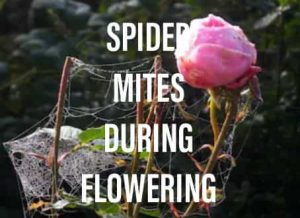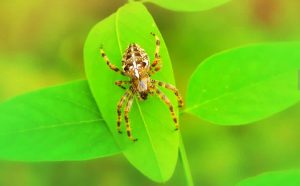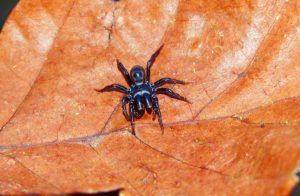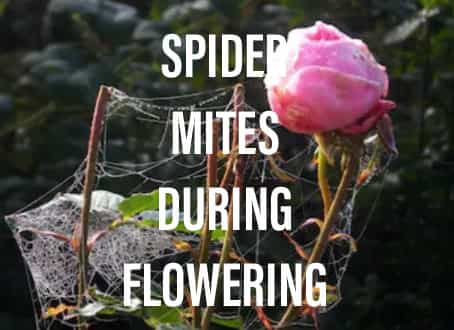Many kinds of pests and diseases attack plants and crops. Growers and cultivators always aim to keep the plants safe from such pests. In case of attack, it becomes a challenge to combat the pests. Many kinds of potential pests can attack and harm the plants. One such common pest is a spider mite. Before flowering, you can easily face the control the pests with remedies like chemical pesticide medicines and sprays. However, nobody wants that the buds and flowers of their plants especially crops and fruits absorb the chemicals. These chemicals will seep in the flowers altering their taste and becoming harmful for the users. So, if unfortunately, your plants get a spider mite attack in their flowering stage, it becomes somewhat tricky to get rid of them.
In this article, we will discuss how to get rid of spider mites during flowering, along with an introduction to spider mites.
Spider Mites

- Spider mites are tiny bugs with 8 legs. They belong to the family Tetranychidae, class Arachnida, and subclass Atari. There are around 1,200 species in this family.
- The size of spider mites is usually less than 1mm or 0.04 inches. The color usually varies in the mites.
- They Reproduce and multiply by laying eggs on the underside of the leaves. These eggs are transparent in the beginning and turn white later on. The majority of the bugs create silk webs intending to hide from the predators.
- These bugs puncture the leaf surface to obtain their nourishment. Additionally, they suck chlorophyll from the leaves. While chlorophyll is the pigment-producing substance of the leaf. This green substance helps the plant to produce its food during photosynthesis.
- As a result of this suction, the leaf surface develops white or yellowish patches. This is called ‘stippling’ on the leaf. This is usually the first sign which informs the grower about the attack of the mites on the plants or crop. Furthermore, the plants get a weekday by day. If left uncontrolled, the leaf eventually loses all of its energy and falls.
- Growth Habitat: A hot and dry habitat is suitable for the mites. The perfect temperature for the eggs to hatch is around27 degrees centigrade.
- Growth and multiplication rate: The growth and multiplication rate of the spider mites are pretty fast. An average female mite gives around 30 eggs daily. The life span of the undisturbed mites is around 1 to 2 months. So a female lays almost 900 to 1800 eggs in its total life span. Eggs hatch in almost 72 hours i.e.3 days. Additionally, the growth rate is very fast. A baby mite gets adult and sexually active in 5 to 7 days. From these statistics, you can imagine the speed and intensity of infestation.
Prevention of Spider mites

It is commonly said that ‘prevention is better than cure. So if you are thinking about ‘how to get rid of spider mites during flowering’ and the plants are not infested yet, we will recommend some precautionary measures. In the case of spider mites, it is always better to stop the invasion from taking place in the first step.
- Spider mites reach the plants through some carrier which is usually a human being. It is better not to allow visitors to visit the cropping areas. This will help you to avoid any riding 8-legged invaders.
- If you have recently visited a garden and especially infected plants, always meet your plants after a good bath and clean clothes.
- If a severe attack has destroyed plants in an area, always thoroughly clean the area with suitable measures.
- You can consider spreading diatomaceous earth around the soil, pots, and the boundaries of the growing area. This dries and kills the bugs who try to cross it. Consequently, you will be creating a guard to prevent the mites from reaching the plants.
How to Get Rid of Spider Mites During Flowering

It is best and preferable to control the spider mites attack as early as possible. The reason being, the delay will result in further multiplication of the bugs and severity of the attack.
Using ordinary chemical pesticides is the last resort. This is when the pest infestation is on its final level and other methods do not seem helpful. However, these sprays will penetrate the buds and flowers of the plants. Furthermore, you can’t even use these sprays for some plants like cannabis. These are used for smoking and nobody would like to smoke the chemicals or affect their medicine with the chemicals.
The common answers to the question “How to get rid of spider mites during flowering” are described below:
- Prune and Manual Pick.
- Alcohol solution wash.
- Predators.
- Carbon dioxide gas spray.
- Essential Oils spray.
- Chemical Pesticides.
In this section, we are describing each method one by one;
1. Prune and Manual Pick:
This is a combination of manual picking of mites and pruning of infected leaves. First of all, you need to have a close look at the plant. If the pest attack is minor, you can decide to deal with it by this method. The bugs and eggs are too small to be seen by the naked eye. So, severe infestation can’t be treated by this method.
The leaves in which more than half of the surface is destroyed, you need to chop them off. Simply cut the leaves with webs and destroyed with a patchy infestation. In this way, pruning will help the plant to conserve its resources. Secondly, you can remove the mites with hands or by using a vacuum tube. Repeat the process multiple times, until you find no further destroyed leaves and bug colonies.
It is important to destroy the bugs. If they are left alive around the plants or in the cropping area, they will surely come to the plant again and infest it. So, in case of manual picking, you need to be gross by squishing them. In case of a vacuum tube, make sure to empty the tube in a sealable bag. As a next step, discard the bag very far away from the growing area. Destroying the bag by burning is also a good option to protect the plants in the surrounding areas.
Pros of Manual Picking:
- It is an inexpensive method compared to other methods. You can do it without any expensive equipment.
- In the case of a single plant like indoor plants, this is a preferable method.
Cons of Manual Picking: - This is time taking, tiring method, and somewhat gross method.
- This method is only usable for the initial stages of infestation.
2. Alcohol Solution Wash:
The next method for the task ‘How to get rid of spider mites during flowering’ is Alcohol washing. In this method, you simply wash the plant by hosing. A 1:9 mixture of isopropyl alcohol and water is used to clean the spider mites and their eggs. Make sure to use a gentle showerhead, as you don’t want to destroy the leaves and the flowers of the plants.
Importantly, pay special attention to the undersides of the leaves, as the bugs and eggs are resident there. The alcohol in the water will kill the majority of the spider mites and their eggs. Additionally, the webs will also be washed away.
In the case of a single plant, you can simply wipe the leaves with the mixture without using the spray.
Some people simply use water to wash the spider mites and their webs. However, water alone is not enough to combat the attack. The reason being, that it will simply blow the mites away instead of killing them. Consequently, the bugs will come to the leaves again for re-infestation.
Pros of Alcohol Solution Wash:
- This is a strong and chemical-free method.
- It can be used up till average infestation severity.
3. Predators:
If you are thinking about ‘how to get rid of spider mites during flowering’, you should also consider using predators.
Basically, this is a practical application of the popular strategy ‘The enemy of my enemy is my friend’. In this method, you have to introduce larger predating bugs which should be harmless for the plants. The cute looking ladybugs are a common option as the predators. These bugs will eat up the spider mites and their eggs. After that, they will simply fly away, leaving a clean plant area. Apart from ladybugs, many other types of bugs and thrips will feast upon the spider mites.
Pros of Using Predators:
- This is a chemical-free and effective method.
Cons of Using Predators:
However, there is one drawback to this method. The predator bugs’ eating rate can’t equalize the multiplication rate of spider mites. Consequently, this method is only helpful in the initial stages of the attack.
4. Carbon dioxide Gas:
The next option for the issue ‘how to get rid of spider mites during flowering’ is the use of Carbon dioxide gas.
Equipment:
You need the under mentioned equipment;
- CO2 Gas Cylinder along with a regulator.
- Vacuum Cleaner.
- Meter to measure the pressure of the gas.
- Brushes to clean the plants.
Method:
- In a properly sealed growing area, set the gas meter for 12,000 ppm. On the other hand, if the plants are in a tent house, 15,000 ppm is suitable. This is to cover the wastage of the gas. Using a ppm calculator to measure the ideal pressure is better in case the pressure pump can’t produce higher pressure.
- Calculate the required gas amount for your growing area. Online calculators are also available for accurate calculation.
- Finally after doing all the arrangements, now switch on the generator.
High quantity and pressure of carbon dioxide will cause suffocation and may result in death. So, it is important to leave the area right after you switch on the generator. - Once the required pressure is obtained, you can now switch off the generator. Don’t forget to switch on the exhaust fans for about one hour to remove the gas before entering the room. This is essential to avoid carbon dioxide gas poisoning.
- The next step in the process is to clean the plants using a vacuum cleaner. Make sure to use it on suitable intensity as you don’t want to destroy the plant with the vacuum pressure.
You can also use the painting brushes to clean the leaves in an upward direction. This will clean the bugs, eggs, and webs. - For a complete cleanup, this whole process needs repetition in the next 5 days.
Pros of using Carbon dioxide:
- Carbon dioxide gas is a nonpoisonous gas and harmless for the plants. This will be a strong method to get rid of the spider mites along with their eggs. And this, without using harmful chemicals.
- The gas will enhance the growth of plants. Also, it will help the plant to get over the negative effects of the bugs.
Cons of using Carbon dioxide:
This method however has its limitation. It is preferable for plants in a closed area or under a tent. The reason being, that you need to cover and seal the area to avoid any leakage and wastage of the gas.
5. Essential Oils:
If you are worried about ‘how to get rid of spider mites during flowering’, another option is using essential oils.
Neem oil is one of the most popular essential oil for combating pest attacks. You can dilute it with water and spray it on the plants. This has a strong odor and a bitter taste, strong enough to kill the bugs and their eggs.
Pros of using Essential Oils:
This is a strong yet organic method to get rid of the pest infestation.
Cons of using Essential Oils:
- Contrastingly, Excess quantities of Neem oil can be harmful to the plants.
- Also, buds, flowers, and especially the fruiting plants should better not absorb it because of its bitter taste.
- Neem oil can not be used near harvesting of the crops of fruits. The reason being, that the strong oil will contaminate the buds and fruit.
Other essential oils for pest control include cinnamon, eucalyptus, peppermint, and rosemary essential oil.
6. Chemical Pesticides:
If you are not getting any helpful option for ‘how to get rid of spider mites during flowering’, using a chemical pesticide is the last resort. It is used when the plant is severely infected and milder methods do not look helpful.
Pros of Chemical Pesticides:
Markets are full of all kinds of pesticides including sprays, tablets, and soaps. These are strong and quick enough to give a ‘clean sweep’ to the spider mites. These sprays are pretty suitable for garden and non-eatable plants.
Cons of Chemical Pesticides:
These chemicals are strong and reduce the ‘organic level’ of the crops and fruits.
Related Post:
Conclusion
Spider mites are tiny pests that infest and destroy the plants in a matter of days. Prevention is always better than cure, especially in the case of spider mites. Chemical pesticides are not suitable for combating the spider mites in the flowering stage of the plant. The reason being, for edible plants, nobody wants the flowers to absorb the harmful chemical pesticides.
Once the bugs attack, there are few options to combat the spider mites. Manual Picking and using predators are suitable options for the initial stages. Carbon dioxide and Alcohol isopropyl solution are strong and non-poisonous methods. Using Essential oils (like neem) is also a strong organic method to get rid of spider mites during flowering.

